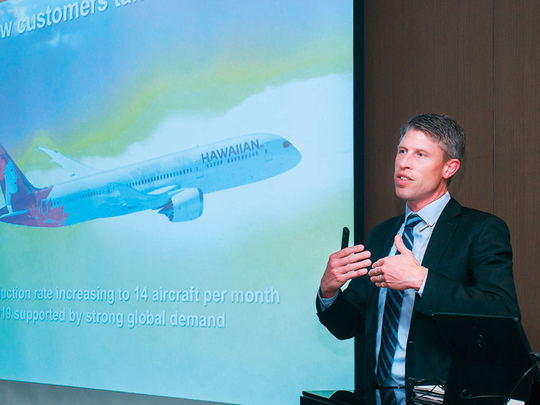
Sydney: Airplane manufacturer Boeing is in talks with Gulf carriers and other Middle Eastern airlines about potentially selling them a new aircraft model that caters to demand for mid-range planes.
The new aircraft, the so-called Boeing 797, is still at the concept stage, with Boeing yet to decide on whether it will launch productions. But the customer response globally so far has been “very positive,” according to Darren Hulst, senior managing director of marketing at Boeing.
In an interview with Gulf News, Hulst said Boeing is “interested in this market space” of mid-sized aircraft, and is looking at a future aeroplane it might produce that could fly as long as around 10 hours and have a capacity of between 200 and 300 seats.
“We’re looking at it as a middle-of-the-market aeroplane; an aeroplane that would be larger and more capable in terms of range than the 737s and the A320s out there, and smaller and less costly than today’s wide-body aeroplanes,” he said.
“We’re looking at entering the service, if we were to launch the aeroplane, in the middle of the 2020s.”
And Boeing believes the 797 will cater to airline demand that is currently neither served by narrow-bodies nor wide-bodies. The growing market of long-haul low-cost flights would also be well-served with a 797, Hulst said.
The company has so far pitched the new model to close to 60 customers around the world.
“I think airlines in the Middle East, in the Gulf, have shown very similar interest to what we’ve seen globally in terms of how this aircraft would enable them to grow in different ways and enable them to expand capabilities,” Hulst said.
With a capacity of 200-300 seats, the 797 would be able to carry more passengers than Boeing’s 737 aircraft, but wouldn’t be as large as a 777 aircraft, which some airlines now resort to even on short haul flights, leading to efficiency losses.
The new 797 model is currently under assessment by Boeing and is yet to be designed. Boeing has not yet set a price tag either, saying the price will depend on demand.
“We haven’t talked specifically about how the aeroplane would be designed or the technology, but you can imagine that an aeroplane coming into the middle of the next decade would have significant advances in fuel efficiency, advances in production technology, as well as the technology that drives the structure of the aeroplane,” the senior managing director said.
Bullish outlook
Hulst was speaking on the sidelines of the 74th annual general meeting of the International Air Transport Association (IATA) in Sydney where he also discussed the performance of the commercial aviation market, saying he was bullish.
With global economic growth finally picking up pace in 2017 and a growing middle class around the world, demand for air travel is also accelerating. Boeing is forecasting passenger demand growth of 7 per cent in 2018, down from 8 per cent in 2017 but higher than the 5 per cent average over previous years.
“Last year, we saw the fastest global growth rate in GDP (Gross Domestic Product) that we’ve seen since the great recession [in 2008], and that gives us confidence that we’re not seeing any near-term downturn economically. But if we were to, that is an indicator of a slowdown in air travel as well,” Hulst said.
He added that Boeing’s outlook for demand was strong till the end of this decade.
Boeing deliveries
In terms of deliveries, about 40 per cent of Boeing aircraft go to Asia, with about 20 per cent to US companies, 20 per cent to Europe, and the remaining 20 per cent split between Latin America and the Middle East.
In the region, Hulst said the Middle East has been a growth market for aviation the past 10-15 years, with a 50 per cent growth rate in the last five years.
“Going forward, we’d like to say the centre of gravity for aviation is moving east, meaning Asia continues to take more of a role in terms of demand for aeroplanes,” Hulst said. “In our long-term outlook, over 40 per cent of demand for aircraft going forward will be for airlines in Asia Pacific.”









